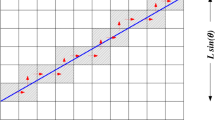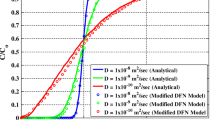Abstract.
Discrete network models are one of the approaches used to simulate a dissolved contaminant, which is usually represented as a tracer in modeling studies, in fractured rocks. The discrete models include large numbers of individual fractures within the network structure, with flow and transport described on the scale of an individual fracture. Numerical simulations for the mixing characteristics and transfer probabilities of a tracer through a fracture intersection are performed for this study. A random-walk, particle-tracking model is applied to simulate tracer transport in fracture intersections by moving particles through space using individual advective and diffusive steps. The simulation results are compared with existing numerical and analytical solutions for a continuous intersection over a wide range of Peclet numbers. This study attempts to characterize the relative concentration at the outflow branches for a continuous intersection with different flow fields. The simulation results demonstrate that the mixing characteristics at the fracture intersections are a function not only of the Peclet number, but also of the flow field pattern.
Similar content being viewed by others
Author information
Authors and Affiliations
Additional information
Electronic Publication
Rights and permissions
About this article
Cite this article
Li, G. Tracer mixing at fracture intersections. Env Geol 42, 137–144 (2002). https://doi.org/10.1007/s00254-001-0483-x
Received:
Accepted:
Published:
Issue Date:
DOI: https://doi.org/10.1007/s00254-001-0483-x




